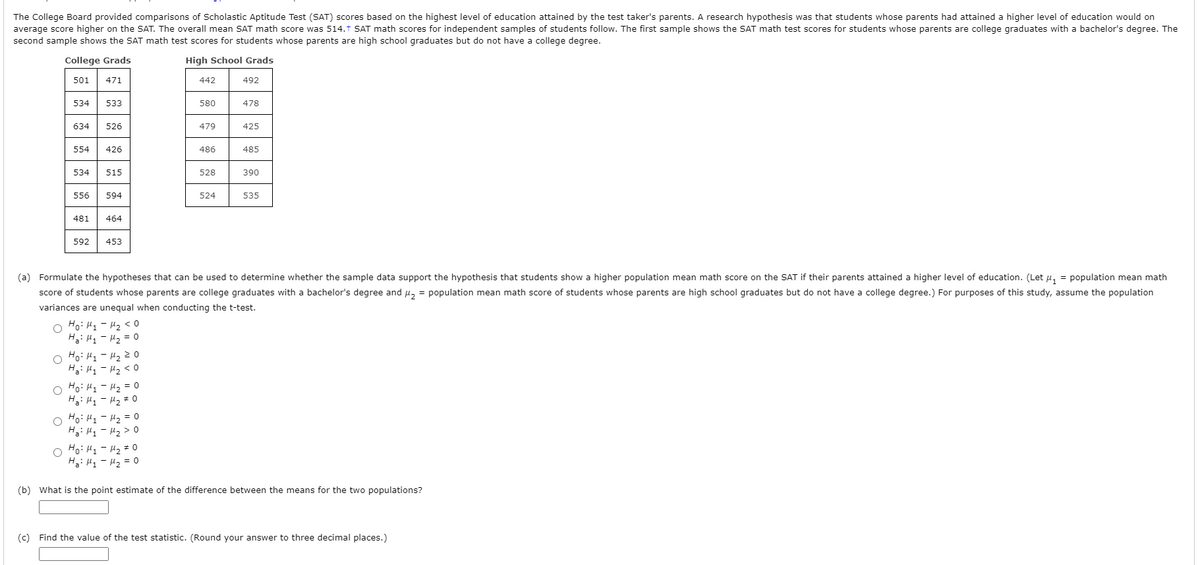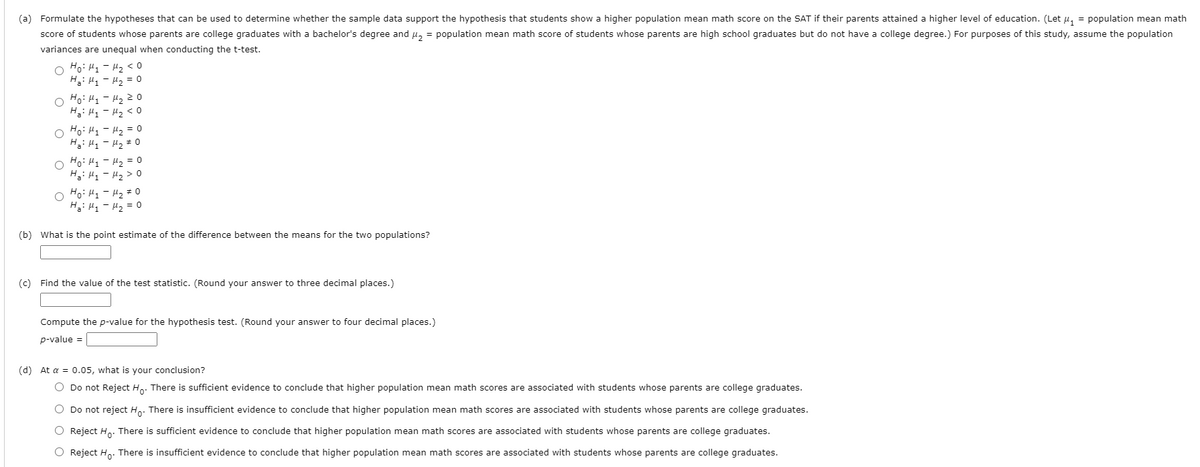College Board provided comparisons of Scholastic Aptitude Test (SAT) scores based on the highest level of education attained by the test rage score higher on the SAT. The overall mean SAT math score was 514.1 SAT math scores for independent samples of students follow. The first sample shows the SAT math test scores for students whose parents are college graduates with a bachelor's degree. The ond sample shows the SAT math test scores for students whose parents are high school graduates but do not have a college degree. takers parents. A r esearch hypothesis was that students whose parents had attained a higher level of education would on College Grads High School Grads 501 471 442 492 534 533 580 478 634 526 479 425 554 426 486 485 534 515 528 390 556 594 524 535 481 464 592 453 OFormulate the hypotheses that can be used to determine whether the sample data support the hypothesis that students show a higher population mean math score on the SAT If their parents attained a higher level of education. (Let u, = population mean math score of students whose parents are college graduates with a bachelor's degree and a, - population mean math score of students whose parents are high school graduates but do not have a college degree.) For purposes of this study, assume the population variances are unequal when conducting the t-test. O "o: H1 - H2 <0 O Mo: Hg - Hz z 0 O Ho: H1 - H2 = 0 O Ho: H - H2= o Hoi Hi - Hz > 0 O Ho: H: - H2 0
College Board provided comparisons of Scholastic Aptitude Test (SAT) scores based on the highest level of education attained by the test rage score higher on the SAT. The overall mean SAT math score was 514.1 SAT math scores for independent samples of students follow. The first sample shows the SAT math test scores for students whose parents are college graduates with a bachelor's degree. The ond sample shows the SAT math test scores for students whose parents are high school graduates but do not have a college degree. takers parents. A r esearch hypothesis was that students whose parents had attained a higher level of education would on College Grads High School Grads 501 471 442 492 534 533 580 478 634 526 479 425 554 426 486 485 534 515 528 390 556 594 524 535 481 464 592 453 OFormulate the hypotheses that can be used to determine whether the sample data support the hypothesis that students show a higher population mean math score on the SAT If their parents attained a higher level of education. (Let u, = population mean math score of students whose parents are college graduates with a bachelor's degree and a, - population mean math score of students whose parents are high school graduates but do not have a college degree.) For purposes of this study, assume the population variances are unequal when conducting the t-test. O "o: H1 - H2 <0 O Mo: Hg - Hz z 0 O Ho: H1 - H2 = 0 O Ho: H - H2= o Hoi Hi - Hz > 0 O Ho: H: - H2 0
Glencoe Algebra 1, Student Edition, 9780079039897, 0079039898, 2018
18th Edition
ISBN:9780079039897
Author:Carter
Publisher:Carter
Chapter10: Statistics
Section10.6: Summarizing Categorical Data
Problem 30PPS
Related questions
Topic Video
Question

Transcribed Image Text:The College Board provided comparisons of Scholastic Aptitude Test (SAT) scores based on the highest level of education attained by the test taker's parents. A research hypothesis was that students whose parents had attained a higher level of education would on
average score higher on the SAT. The overall mean SAT math score was 514.1 SAT math scores for independent samples of students follow. The first sample shows the SAT math test scores for students whose parents are college graduates with a bachelor's degree. The
second sample shows the SAT math test scores for students whose parents are high school graduates but do not have a college degree.
College Grads
High School Grads
501
471
442
492
534
533
580
478
634
526
479
425
554
426
486
485
534
515
528
390
556
594
524
535
481
464
592
453
(a) Formulate the hypotheses that can be used to determine whether the sample data support the hypothesis that students show a higher population mean math score on the SAT if their parents attained a higher level of education. (Let u, = population mean math
score of students whose parents are college graduates with a bachelor's degree and u, = population mean math score of students whose parents are high school graduates but do not have a college degree.) For purposes of this study, assume the population
variances are unequal when conducting the t-test.
O Ho: H1 - Hz < 0
Hai H1- Hz = 0
O Ho: H1 - H2 2 o
O Ho: H1 - H2 = 0
Hai Hy - Hz#0
O Ho: H1 - H2 = 0
Hai H1- Hz>0
Hoi Hy- Hz #0
Hai Hy - Hz = 0
(b) What is the point estimate of the difference between the means for the two populations?
(c) Find the value of the test statistic. (Round your answer to three decimal places.)

Transcribed Image Text:(a) Formulate the hypotheses that can be used to determine whether the sample data support the hypothesis that students show a higher population mean math score on the SAT if their parents attained a higher level of education. (Let u, = population mean math
score of students whose parents are college graduates with a bachelor's degree and u, = population mean math score of students whose parents are high school graduates but do not have a college degree.) For purposes of this study, assume the population
variances are unequal when conducting the t-test.
Ho: Hy - H2 < 0
Ha: H1 - H2 = 0
O Ho: H1 - H2 2 0
O Ho: H1 - H2 = 0
Hai Hy - Hz # 0
Ho: H - H2 = 0
Hai Hy - Hz> 0
Ho: H1 - H2 #0
H: H1 - H2 = 0
(b) What is the point estimate of the difference between the means for the two populations?
(c) Find the value of the test statistic. (Round your answer to three decimal places.)
Compute the p-value for the hypothesis test. (Round your answer to four decimal places.)
p-value =
(d) At a = 0.05, what is your conclusion?
O Do not Reject Ho. There is sufficient evidence to conclude that higher population mean math scores are associated with students whose parents are college graduates.
O Do not reject Ho: There is insufficient evidence to conclude that higher population mean math scores are associated with students whose parents are college graduates.
O Reject Ho. There is sufficient evidence to conclude that higher population mean math scores are associated with students whose parents are college graduates.
O Reject Ho: There is insufficient evidence to conclude that higher population mean math scores are associated with students whose parents are college graduates.
Expert Solution
Step 1
Solution:
Let x= College grades and y = Highschool grades.
Trending now
This is a popular solution!
Step by step
Solved in 2 steps

Knowledge Booster
Learn more about
Need a deep-dive on the concept behind this application? Look no further. Learn more about this topic, statistics and related others by exploring similar questions and additional content below.Recommended textbooks for you

Glencoe Algebra 1, Student Edition, 9780079039897…
Algebra
ISBN:
9780079039897
Author:
Carter
Publisher:
McGraw Hill

College Algebra (MindTap Course List)
Algebra
ISBN:
9781305652231
Author:
R. David Gustafson, Jeff Hughes
Publisher:
Cengage Learning

Glencoe Algebra 1, Student Edition, 9780079039897…
Algebra
ISBN:
9780079039897
Author:
Carter
Publisher:
McGraw Hill

College Algebra (MindTap Course List)
Algebra
ISBN:
9781305652231
Author:
R. David Gustafson, Jeff Hughes
Publisher:
Cengage Learning